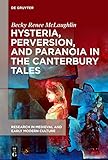Hysteria, Perversion, and Paranoia in “The Canterbury Tales” : “Wild” Analysis and the Symptomatic Storyteller / Becky Renee McLaughlin.
Material type: TextSeries: Research in Medieval and Early Modern Culture ; 25Publisher: Kalamazoo, MI : Medieval Institute Publications, [2020]Copyright date: ©2020Description: 1 online resource (VIII, 295 p.)Content type:
TextSeries: Research in Medieval and Early Modern Culture ; 25Publisher: Kalamazoo, MI : Medieval Institute Publications, [2020]Copyright date: ©2020Description: 1 online resource (VIII, 295 p.)Content type: - 9781501518416
- 9781501514067
- 9781501514104
- 821/.1 23
- PR1874 .M38 2020
- PR1874 .M35 2020
- online - DeGruyter
- Issued also in print.
| Item type | Current library | Call number | URL | Status | Notes | Barcode | |
|---|---|---|---|---|---|---|---|
 eBook
eBook
|
Biblioteca "Angelicum" Pont. Univ. S.Tommaso d'Aquino Nuvola online | online - DeGruyter (Browse shelf(Opens below)) | Online access | Not for loan (Accesso limitato) | Accesso per gli utenti autorizzati / Access for authorized users | (dgr)9781501514104 |
Frontmatter -- Contents -- Acknowledgments -- Introduction, or A Long Preamble to a Tale -- Chapter 1: The Prick of the Prioress, or Hysteria and Its Humors -- Chapter 2: Portrait of the Hysteric as a Young Girl -- Chapter 3: Masochist as Miscreant Minister: The Parable of the Pardoner’s Perverse Performance -- Chapter 4: Confessing Animals -- Chapter 5: Before There Was Sade, There Was Chaucer: Sadistic Sensibility in the Tales of the Man of Law, the Clerk, and the Physician -- Chapter 6: Sadomasochism for (Neurotic) Dummies -- Chapter 7: The Reeve’s Paranoid Eye, or The Dramatics of “Bleared” Sight -- Chapter 8: Farting and Its (Dis)contents, or Call Me Absolon -- Chapter 9: Retractor -- Bibliography -- Index
restricted access online access with authorization star
http://purl.org/coar/access_right/c_16ec
Beginning with the spectacle of hysteria, moving through the perversions of fetishism, masochism, and sadism, and ending with paranoia and psychosis, this book explores the ways that conflicts with the Oedipal law erupt on the body and in language in Chaucer’s Canterbury Tales, for Chaucer’s tales are rife with issues of mastery and control that emerge as conflicts not only between authority and experience but also between power and knowledge, word and flesh, rule books and reason, man and woman, same and other – conflicts that erupt in a macabre sprawl of broken bones, dismembered bodies, cut throats, and decapitations. Like the macabre sprawl of conflict in the Canterbury Tales, this book brings together a number of conflicting modes of thinking and writing through the surprising and perhaps disconcerting use of “shadow” chapters that speak to or against the four “central” chapters, creating both dialogue and interruption.
Issued also in print.
Mode of access: Internet via World Wide Web.
In English.
Description based on online resource; title from PDF title page (publisher's Web site, viewed 25. Jun 2024)


